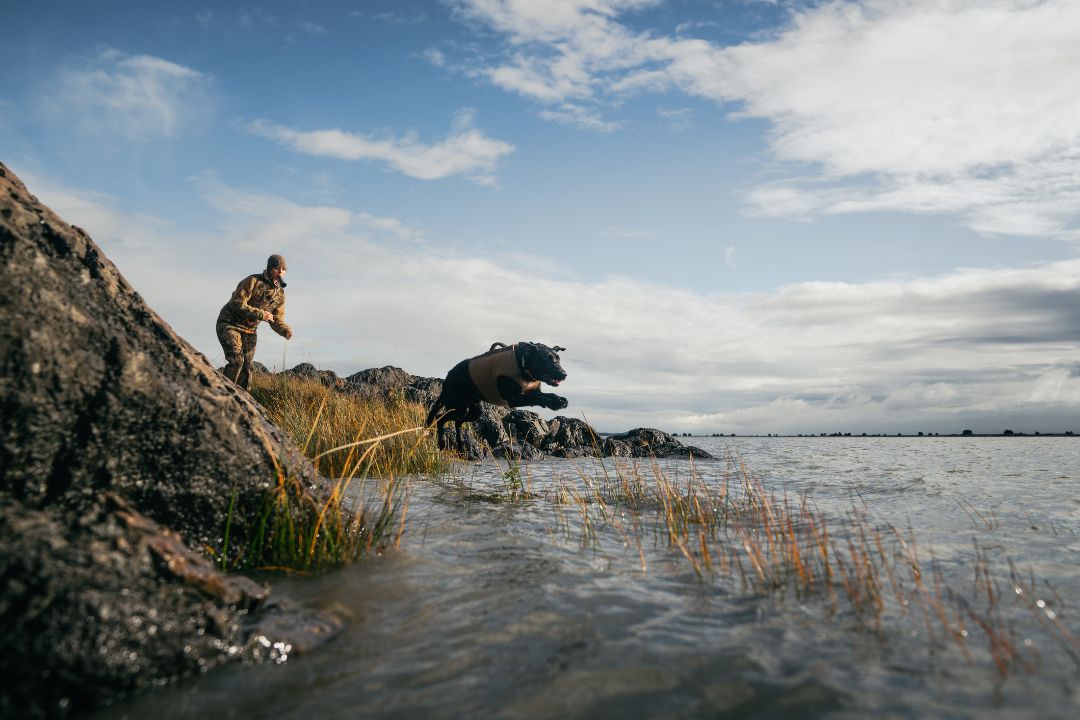Migratory Bird Hunting: Basic Tips for Planning Your Next Hunting Trip
Hunting | March 24, 2024
SAIL
April 28, 2023

Waterfowl hunting is quite an art, testing the adaptability of even the most avid hunters. For novices, it also opens up a whole new world of possibilities. See it through the eyes of Juliette Larocque as she undertakes her first expedition on Île au Canot, accompanied by Caroline Grimard and her retrieving dog Goose. With them, you will discover how duck hunting can be a vehicle for discovery and fulfillment.
This article was written in collaboration with Hooké.
In this article, you will learn more about the beauty and challenges of duck hunting:
It is the end of September, and a surprisingly warm sun shines over the calm surface of the river. The boat is gliding its way through the cluster of islands with a reassuring hum. On board, Juliette Larocque is contemplating her luck and the incongruity of her presence in these parts. Île au Canot is the kind of place you only hear about in small circles of waterfowlers. The island, a hidden gem in the Saint Lawrence Estuary, is part of the Isle-aux-Grues archipelago. As the sun sets, you can see the distant cliffs of Saint-Tite-des-Caps glowing in its soft light. On the other side, the coasts of Cap-Saint-Ignace are disappearing behind the île aux Grues. “This is my homeland,” Juliette thinks, “this is my homeland, and I would never have set foot here if it weren’t for hunting.” Hunting… Hunting, and nothing else.
In this particular case, it is the experience of hunting geese with a retrieving dog that brought Juliette to this part of the province. She is a novice, and this is her first time waiting for game at the meeting point of water and land, where birds flock in search of food and cover. There is no trace of first-timer’s nerves, though; Juliette is in good company with her mentor Caroline Grimard, an avid waterfowler and experienced hunting dog breeder. It is with excitement and joyful anticipation that she watches the boat move toward to the last hunting site of the trip.
The day before, the mentor and mentoree established that large numbers of geese have yet to arrive in the province, which means there are not enough for goose hunting. Luckily, duck hunting season just opened in Quebec, and the archipelago is home to a great diversity of migratory birds. The first flock to fly in front of the blind is of blue-winged teal, a duck known for its agile flight and unpredictable approach. Hunting this bird can seriously shake the confidence of someone expecting to aim at big, plump geese. It is challenging enough to make a good shot at a goose in flight, even more so at a bird five times smaller whose approach is as predictable as a leaf in the wind. Still, being exposed to the wild, elusive qualities of nature is what gives all its beauty to the adventure of hunting.
It took a successful clay target shooting session to reassure Juliette and bring her confidence back up – something she vows to do as often as she can before her next hunting trips. As she helps Caroline with the placement of decoys, Juliette glances at Goose. The beautiful black Labrador retriever waits patiently on the shore, gaze fixed on the horizon, his duck-dog ears perking up at the barely perceptible calls of flocks in the distance. It is quite impressive to see this hound in action; plunging into the cold waters of the Saint Lawrence River is no small feat, let alone blindly trusting his owner’s commands to retrieve a bird he cannot see. With any luck, it will be a lively evening for Goose.
About a hundred metres left of the improvised blind she set up in the rocks, a pair of teals flying at a low altitude are echoing Caroline’s calls. At first, the distance holds the two hunters in a sort of numbness; the universe of possibilities is still too vast to get excited. But the thrill quickly takes over as the birds change course in a coordinated movement. Stupor ensues for Juliette; though she hears a resonating “Go!” coming out of Caroline’s mouth, her mentor is the only one firing shots. “I thought I was ready. But no”. Juliette stands next to her guide, listening to her reassuring words and watching Goose come back with the second duck. Long minutes pass as she wonders if she will get a second chance, then another flight of ducks appears in front of her eyes. There are six, flying at a similar angle as the first duo. This time, no hesitation: senses are wide awake. “Get ready,” says Caroline. Juliette’s hands tighten on the barrel of the 12-gauge shotgun, then immediately relax. “Breathe,” she reminds herself. “GO!”
As she watches water droplets beading up on the plumage of her first Île au Canot duck, Juliette can’t help but think about what brought her to this place. About what makes the harvest she’s holding in her hands so precious. It is a marvel of natural engineering, found in an intimate setting where the sound of the wind and the river, the salty smell of the Saint Lawrence, and the complicity of an amazing duo all come together. Hunting. Hunting, and nothing else.
You can watch episode 3 “Fidèle partenaire dans l’estuaire du fleuve Saint-Laurent” of the “Intrépide de nature” series (in French with English subtitles) to get your own taste of a hunting adventure on Île au Canot.